Fast Services that Link Important Centres
RAILWAYS OF BRITAIN - 34
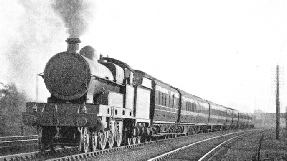
THE “DEVONIAN”, a daily express operating between Bradford, Leeds, Sheffield, Derby, Birmingham, Bristol, Exeter, Torquay, Paignton, and Kingswear (Devon). The 206 miles between Leeds and Bristol are covered in four hours forty minutes. The above illustration shows the train near Breadsall (Derby), hauled by a four-cylinder LMS locomotive of the “Claughton” class, formerly of the London and North Western Railway.
SO much is heard of the famous flyers which travel over the main lines to and from London that the important cross-country services are often overlooked. The former radiate from the capital in the manner of the spokes of a wheel; but the lateral train services, which join the spokes together, are of little less importance.
There are certain stretches of railway in Great Britain which form vital links in the development of cross-country transport. One is the Swinton and Knottingley Joint Line, built to connect the former Midland and Great Central lines at Swinton to the north of Rotherham, Yorkshire, with the former North Eastern Railway at Ferrybridge, near Knottingley, thus opening up direct communication between York and the Sheffield area.
This line, sixteen miles in length, was jointly constructed by the Midland, Great Central, and North Eastern Railways and, as will be seen later, is followed daily by trains giving through communication to and from all parts of England and Scotland.
Another important line runs from Woodford and Hinton, fourteen miles south of Rugby on the Great Central main line of the LNER, to Banbury, on the Great Western Railway main line from Paddington to Birmingham. When the Manchester, Sheffield and Lincolnshire Railway - as the Great Central was formerly known - extended southwards in 1899, its nearness to the GWR in the Banbury area suggested the desirability of thus linking up the two systems. The connexion, nine miles in length, has since proved of the utmost value in developing cross-country services.
The LMS main line from Derby to Birmingham, Cheltenham, Bath, and Bristol is another path frequented by cross-country trains. It is paralleled on the opposite side of the Severn by the Shrewsbury and Hereford line, jointly owned and worked by the LMS and GW Railways, which similarly connects north and west, but by way of the Severn Tunnel.
Across the centre of England there are three busy main lines connecting Yorkshire with Lancashire. Two of them run from Leeds to Manchester and Liverpool, and the third joins Sheffield and Manchester. The first two were built originally by the London and North Western and Lancashire and Yorkshire Railways; both are now LMS property. The third was part of the former Manchester, Sheffield and Lincolnshire main line. All three, with very heavy gradients and the help of some of the longest tunnels in England, have to penetrate the Pennines on their course.
The longest cross-country journey that is possible in Great Britain without change of carriage is from Aberdeen to Penzance, and vice-versa.
It is only in the summer that the full through working obtains; during the winter the through coach, alternately LNER and Great Western stock works between Edinburgh and Penzance only. It leaves Aberdeen at 10.20 am, travelling down through Montrose and Dundee with an East Coast luncheon car train to Edinburgh. Here it is attached to the rear of the 2.5 pm express to London, reaching York at 6.14 pm. To this point the coach has covered 335 miles.
At York, the through coach is detached and made up into a train with another through coach from Glasgow to Swindon, which has preceded it from Edinburgh, a buffet car, and additional coaches and parcels vans. The train leaves for Sheffield at 6.30 pm by way of Church Fenton and the Swinton and Knottingley Joint Line, already mentioned.
From Sheffield the Great Central main line is followed through Nottingham, Leicester, and Rugby to Woodford. Hence the train passes over the Woodford-Banbury link, and is handed over to the Great Western Railway at Banbury at 10.7 pm, having travelled 489 miles over LNER metals.
The next stage of the journey lies through Oxford, and round the west curve at Didcot, Swindon being reached at 11.32 pm. Here the Penzance coach parts company with the vehicles with which it has travelled from York. It is attached to the 9.50 pm from Paddington to Penzance, which follows it into Swindon at 11.48 pm. This train leaves at midnight for Bristol, Plymouth and Penzance. which is reached at 7.45 am, after a journey lasting 21 hours, 25 minutes, and covering 794 miles. In winter the Penzance arrival is 7.30 am.
A service of considerable importance which works over the same route between York and Banbury is that which was inaugurated in 1905 to connect Newcastle-on-Tyne with South Wales.
“Ports to Ports Express”
The “Ports to Ports Express” is an appropriate title sometimes used for this train. It links Newcastle and Hull by through coaches, and Sunderland. West Hartlepool, and Middlesbrough by connexions, with Newport, Cardiff, Barry, and Swansea. Intermediately the train serves Sheffield, Nottingham, Leicester, Banbury, and Cheltenham. Between Newcastle and Swansea it is a complete restaurant car train, composed on alternate days of LNER and Great Western stock.
Leaving Newcastle at 9.30 am, the southbound express now suffers the indignity of being “looped” between Northallerton and Thirsk, to let the “Silver Jubilee” fly past. It reaches York at 11.27 am, and leaves again at 11.42 am. The fastest section of the journey is in the reverse direction over the 23.4 miles from Nottingham to Leicester, which are allowed only twenty-six minutes. The slowest section is beyond Banbury, where the train crosses the Cotswolds over the single-line branch from King’s Sutton to Cheltenham through Chipping Norton, Stow-on-the-Wold, and Bourton-on-the-Water. It is the only express ever to be seen in this part of the country. The Banbury-Cheltenham section of forty-five miles is allowed eighty-two minutes, and GWR “Moguls” must be used, as the gradients are very steep and no heavier engines than these are permitted on this branch. A remarkable illustration is thus afforded of the manner in which an out-of-the-way section of line may suddenly acquire prominence by being brought into service as a direct link in the development of some cross-country service of this kind.
From Cheltenham the route is straightforward through Gloucester to Newport and Cardiff, reached at 6.51 pm. Then comes a diversion round the coast southwards to touch Barry, where at one time the service came to an end. It now continues over the line of what was once the Barry Railway to Bridgend, where the Swansea main line is regained. Swansea is reached at 8.45 pm, after a journey of 397 miles, which has occupied eleven and a quarter hours.

MANY IMPORTANT THROUGH TRAINS between the north and south of England run via York, Sheffield, Nottingham, Leicester, Banbury, and Oxford. At Banbury the Great Western takes over the west-bound trains from the Great Central Section of the LNER. Above is an Oxford-York through train at East Leake (Notts). The locomotive is a Great Central “Atlantic” and the coaches are Great Western stock.
Another cross-country train to follow the same route between York and Banbury is one which concerns the LNE, Great Western, and Southern Railways. It is notable in that, on alternate days, it carries a complete train of Southern Railway rolling stock as far northwards as Newcastle-on-Tyne. The two ends of its daily journey are Newcastle and Bournemouth. Leaving Newcastle at 7.30 am, and following an unusual route by way of Sunderland to Darlington, it reaches York at 9.36 am, having made a fast run over the thirty miles from Northallerton to York in thirty-one minutes, start-to-stop.
At York the train waits for a through coach, which comes down much more quickly from Newcastle to York on the 8.15 am London express. The complete train leaves York at 10.10 am. As before, it travels through Sheffield (where a through coach from Bradford is attached), Nottingham, and Leicester to Banbury, reached at 2.17 pm. At Banbury it is handed over to the GWR. A Great Western locomotive then works the express through Oxford and Didcot nearly into Reading, but it avoids Reading main station by taking the west curve, and so makes its way down to Basingstoke. Here the Southern Railway takes over; in summer the whole train is worked through specially to Bournemouth, but in winter it waits from 4.6 pm until the arrival of the 3.30 pm express from Waterloo to Bournemouth, to which two or three through coaches are attached.
Newcastle to Bournemouth
Leaving at 4.32 pm, the combined train reaches Bournemouth West at 6.27 pm, the journey of 371 miles from Newcastle having occupied all but eleven hours. But the through coach on the 8.15 am from Newcastle reaches Bournemouth Central in exactly ten hours.
Another Newcastle-Bournemouth route served by through coaches takes the traveller over the Swinton and Knottingley Joint Line, but then by way of the Midland Division of the LMS through Sheffield, Derby, and Birmingham to Cheltenham, and from there through Bath and over the Somerset and Dorset Joint Line to Poole and Bournemouth West. A fourth cross-country service which uses both the Swinton and Knottingley Joint Line and the Great Central main line, from York to Banbury, runs between Newcastle and Southampton, in connexion with the Channel Islands steamers. Stock is provided alternately by the GWR and the LNER. The train leaves Newcastle at 12.44 pm, including in its formation a through coach from Glasgow and Edinburgh. It has a lengthy wait at York from 2.23 to 3.0 pm, when it starts away for Sheffield.
At Leicester it may collect a large number of loaded fish wagons which have just arrived from Grimsby, and its running after that is correspondingly slowed down. But from Oxford, where the restaurant car is detached, the travelling becomes slower still, and the through coaches do not finally arrive at Southampton till 10.44 pm, exactly ten hours after the Newcastle departure.
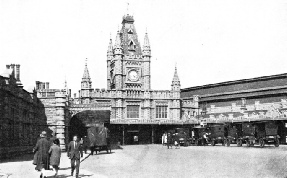
TEMPLE MEADS STATION at Bristol, an important junction on the Great Western Railway, 118¼ miles from Paddington, London, via Bath. It is also the terminus of the important cross-country line of the LMS Midland Division from Derby via Birmingham and Gloucester.
But this is not so slow as the northbound journey, when the train leaves Southampton at the early hour of 7.33 am, meanders across the country from Winchester through Newbury to Didcot by the old Didcot, Newbury, and Southampton single line, calling at every station. It does not even become an express until it leaves Oxford, only sixty-seven miles away, at 10.50 am. Newcastle is reached at 5.22 pm, the run of 324 miles having taken nine hours forty-nine minutes.
The through Glasgow coach then pursues its way to Scotland, finally reaching Glasgow, after a journey of 496 miles, at 9.49 pm, fourteen and a quarter hours after starting. Few, if any, through passengers make end-to-end journeys on such trains as these, as they can travel so much more quickly by way of London; but the trains are useful tor the conveyance of through luggage and parcels, and also for giving through communication intermediately.
The Woodford-Banbury link is used also by a through night train which runs in either direction between York and Swindon. This is of interest because it has produced daily through locomotive workings between Leicester and Swindon. For two years in succession the GWR is responsible and GWR locomotives work into and out of Leicester every night; then for the next two years the LNER takes over, and LNER locomotives are found every night at Swindon ready to make the run of 102 miles to Leicester.
As a result of the through engine working just mentioned, when the LNER locomotives are working through, the engines of all four great railways may be seen at Oxford, where the Great Western and LMS stations adjoin, for the Southern Railway sends its locomotives to Oxford daily throughout the year.
The train concerned is the through daily express between Bournemouth and Birkenhead. This leaves Bournemouth West at 9.30 am, and, after a number of stops, including one at Eastleigh to pick up a section from Portsmouth, passes on to the GWR at Basingstoke and travels via the Reading West curve.
The “Pines Express”
North of Oxford this train runs onwards through Leamington, Birmingham and Wellington (Salop), where it divides, the front portion going on to Shrewsbury, Chester, and Birkenhead (reached at 5.29 pm), and the rear portion to Manchester. This is another example of a little used branch line seeing one daily express, for the route of the Manchester section is over the by-way from Wellington by way of Market Drayton to Nantwich, from which it is but a short run to Crewe. Manchester is reached at 6.25 pm. The Bournemouth-Birkenhead run covers 271 miles and takes eight hours.
Another cross-country service, starting from Birkenhead at 8 am, uses the same route as the Bournemouth train down. through Shrewsbury, Wolverhampton, Birmingham, and Oxford to Reading, but, instead of taking the Reading West curve, it continues into Reading GWR station, which adjoins that of the Southern Railway.
Here a Southern 2-6-0 engine is waiting to haul this express, bound for the Kent Coast over difficult gradients through Aldershot, Guildford, Dorking, and Redhill to Tonbridge, where the Southern main line to Dover is reached. Continuing over this to Ashford, the train divides, half of it proceeding to Folkestone, Dover (4.9 pm), and Deal (4.34 pm), and the other half through Canterbury to Ramsgate and Margate, reached at 4.49 pm.
In this convenient way the north-west and south-cast coasts of England are linked, and useful service is given also between intermediate towns. Both the Birkenhead-Bournemouth and Birkenhead-Dover services are composed alternately of Great Western and Southern Railway rolling stock, and both include restaurant cars in their formations. From Birkenhead to Dover by this cross-country route is a total distance of 307 miles.
There are three independent routes operating between the north and Midlands and the south and west of England. Over them many important cross-country trains are worked, among the chief of these being the “Pines Express” and the “Devonian” of the LMS, which use the West of England main line of the late Midland Railway south-westwards from Birmingham. The “Pines Express” was originally a joint London and North Western and Midland service, beginning its journey at Liverpool and Manchester, and running through to Bournemouth; now, of course, it runs entirely over LMS metals, except at the southern extremity of the journey, where it passes, from Bath onwards, on to the Somerset and Dorset line (LMS and Southern Joint), and finally on to Southern Railway metals.
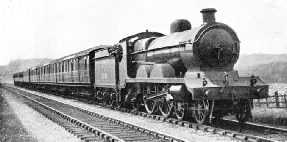
A SOUTHAMPTON-YORK THROUGH EXPRESS. The Great Central 4-4-2 is hauling a train of LNER coaches. Through trains are run between the great port and the cities in northern England. The Newcastle-Southampton train, with through coaches from Glasgow and Edinburgh, runs via York, Sheffield, Leicester, and Oxford, and takes ten hours for the journey.
Leaving Liverpool (Lime Street) at 9.40 am, and Manchester (London Road) at 10 am, the two sections of the train are united at Crewe, and leave there for Birmingham at 10.45 am. On arrival at New Street Station (eighty-seven miles from Liverpool) at two minutes after midday, the “Pines Express” is transferred from Western to Midland Division metals. Here, to avoid reversal, it follows the unusual course of leaving for Cheltenham out of the east instead of the west end of the station, being worked round via Camp Hill on to the West of England main line at King’s Norton. From there the express proceeds down the Lickey Incline and reaches Cheltenham at 1.10 pm.
At Cheltenham a through coach from Liverpool to Southampton is detached to work over the old Midland and South Western Junction Line through Swindon and Andover to the South Coast port. The M&SWJR became fused with the Great Western Railway in the grouping of 1923, and the Liverpool-Southampton coach is accordingly Great Western stock, providing a variation of colour in the otherwise uniformly red livery of this LMS train.
The “Pines Express” leaves Cheltenham at 1.14 pm, and, after calling at Gloucester, diverges from the Bristol main line at Mangotsfield to reach Bath, 182 miles from Liverpool, at 2.15. Reversal is necessary here in Queen Square Station, and there now lie ahead the formidable gradients of the Somerset and Dorset line, with long stretches at 1 in 50 through the Mendip Hills, the summit level being near Binegar, seventeen miles from Bath. Most of the sixty-four miles from Bath to Broadstone, Dorset, are single track. A journey of eight more miles, over Southern metals, brings the train into Bournemouth West at 4.35 pm. The distance covered has been 254 miles from Liverpool and the time occupied but five minutes short of seven hours.
Bradford to Torquay
The northbound “Pines Express” is a little quicker from Bournemouth to Manchester, as it takes six hours twenty minutes in comparison with six hours thirty-five minutes coming south; but the time to Liverpool (six hours fifty-three minutes) is about the same. It leaves Bournemouth West at 10.30 am.
Between Leeds, Sheffield, Derby, Birmingham, and Bristol the “Devonian” is the fastest train of the day. It begins its journey in Forster Square Station at Bradford at 10.25, makes the short run into the Wellington Station at Leeds, and is there reversed. Notwithstanding some severe gradients, especially between Sheffield and Chesterfield, Birmingham and Bromsgrove, and Gloucester and Bristol, and stops at Sheffield, Derby, Birmingham, Cheltenham, and Gloucester, the “Devonian” covers the 206 miles from Leeds to Bristol in the excellent time of four hours forty minutes, arriving in Temple Meads Station at 3.32 pm. At Bristol the Great Western Railway takes charge, and some leisurely progress follows over the remainder of the course to Exeter, Torquay, Paignton, and Kingswear, which is reached at 7.19 pm. The entire journey of 330 miles from - Bradford to Kingswear has thus occupied six minutes under nine hours.
In the reverse direction the “Devonian” starts its daily journey at Paignton at 9.15 am, reaching Bristol, 104 miles away, at 12.11 pm. Again the running over the LMS line is, for a cross-country journey, very fast, and includes a mile-a-minute booking, the thirty-one miles from Cheltenham to Bromsgrove (where a service stop is made to attach the “banker” for the ascent of the Lickey Incline) being allowed only thirty-one minutes start-to-stop.
Leeds is reached at 5.24 pm, after a run of four hours forty-nine minutes from Bristol, and Bradford at 5.56 pm, eight hours forty-one minutes after leaving Paignton. A distinction of the “Devonian”, other than speed, is that of connecting five such important centres of population as Bradford, Leeds, Sheffield, Birmingham, and Bristol with one through service.
Birmingham and Bristol are linked also by the competing services of the Great Western Railway. These use the main line that was opened as recently as 1910 from Tyseley, three miles south of Birmingham, through Stratford-on-Avon and the heart of the Cotswold country to Cheltenham. South of Gloucester the Great Western trains pass at Standish Junction on to the rival LMS route, used as far as Yate, where they travel over a spur on to the Great Western South Wales main line, thus reaching Bristol via Stoke Gifford. This is a very busy route in summer, carrying thousands of holiday-makers between the populous Midland industrial area and the resorts of Devon and Cornwall. Throughout the year a daily restaurant car express runs in either direction between Wolverhampton and Birmingham and Bristol, Exeter, Plymouth, and Penzance, with other services operating between Wolverhampton and Weston-super-Mare.
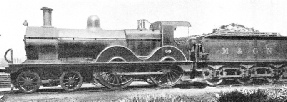
THE MIDLAND AND GREAT NORTHERN JOINT RAILWAY handles a large amount of cross-country traffic. Above is a M & GN 4-4-0 locomotive. This engine has two cylinders 18½-in by 26-in, and coupled wheels with a diameter of 6 ft 6-in. The boiler pressure is 160 lb per sq in, and the total weight of the engine and tender in working order is 76 tons.
The fastest service through Stratford-on-Avon, however, is that provided by the Diesel express rail-cars which work twice daily in either direction between Birmingham and Cardiff. The quickest of these takes two hours twenty-two minutes for the journey of 131 miles, including intermediate stops at Cheltenham, Gloucester, and Newport, so averaging 51.7 miles an hour throughout. West of Gloucester the north bank of the Severn is followed through Chepstow. Another route between Birmingham and South Wales, used by through trains, is by way of Worcester, Malvern, Hereford, and Pontypool Road.
But by far the most important services operating between Hereford and Pontypool Road are those using the historic North to West highway which comes down from Crewe to Hereford by way of Shrewsbury. Between Shrewsbury and Hereford this is a joint LMS and Great Western line, though the express trains are always worked by Great Western locomotives. Throughout this is a route of considerable scenic attraction, particularly at Church Stretton, where the summit-level is attained, after difficult climbs from both the northern and southern sides, and again through the mountainous region round Abergavenny.
At Abergavenny Junction the LMS line to Merthyr Tydfil diverges, attaining an altitude of over 1,000 ft above sea-level among the hills just south of the Brecon Beacons, and connecting up the northern ends of all the lines coming up through the Welsh mining valleys from Newport and Cardiff. This section of the LMS can be reached by the parent company only by the use of running powers over the Great Western between Hereford and Abergavenny Junction.
Along the Welsh Border
Various important trains work every day over the North to West line, carrying through coaches between Manchester and Liverpool, and Plymouth and Penzance. These trains pass through the outskirts of Newport and then reach Bristol by way of the Severn Tunnel. Through portions also run between Manchester and Cardiff, detached and attached at Pontypool Road, and, in certain instances, through coaches to and from Birkenhead, connecting at Shrewsbury. Two new business services in either direction daily were put into operation in the summer of 1935, running between Swansea and Manchester by this route, in faster times than ever previously attempted. Through coaches are also run between Penzance, Plymouth, and Glasgow by way of the Severn Tunnel and Crewe.
Across the centre of England the principal cross-country services are those maintained from Liverpool and Manchester to Leeds and Bradford, York and Newcastle, and Hull. In pre-amalgamation days, four railways were concerned - the North Eastern, which monopolized the coast-line from Newcastle to Hull, and, in connexion with the westward, the London and North Western, Lancashire and Yorkshire, and Great Central Railways. As a result there are three established main routes from Hull across to Manchester and Liverpool. The “all LNE” route - at one time NE and GC - takes the traveller south-westwards to Doncaster and Sheffield, and then climbs for nineteen miles to the west on gradients ranging from 1 in 120 to 135, to Dunford Bridge, which is the entrance to the famous Woodhead Tunnel.

FISHWORKERS’ SPECIAL at Yarmouth Beach Station, Norfolk. The Midland and Great Northern Joint handles cross-country trains from Leicester, Birmingham, Gloucester, and other important towns on the Midland Division of the LMS to Sheringham, Cromer, Norwich, Yarmouth, and Lowestoft. This through train is about to start away for Scotland.
This historic bore, which consists of two parallel tunnels over three miles long, comes out on the west side at Woodhead, and then there is a long downhill run through Guide Bridge into Manchester, the remainder of the journey between Manchester and Liverpool being over the lines of the Cheshire Lines Committee. Certain Hull-Liverpool trains, however, diverge at Godley Junction, and pass through Stockport, to the south of Manchester, thus saving time and distance. From Hull to Liverpool via Sheffield, Godley, and Stockport the distance is 137 miles, and the quickest train takes three hours twenty-seven minutes. The services of the one-time Lancashire and Yorkshire Railway bring LMS locomotives over the LNE lines into Hull. They use the Doncaster route between Hull and Goole, twenty-four miles, and LMS metals from there onwards through Knottingley to Wakefield. From Wakefield the busy main line of the one-time Lancashire and Yorkshire Railway is followed to Manchester and Liverpool. The tunnel which carries this route through the Pennines-Littleborough Summit Tunnel, between Todmorden and Rochdale - is the shortest of any of the trans-Pennine bores, being only just over two miles in length. The distance from Hull to Liverpool by this route is 112 miles (the shortest of the three), and the quickest train takes three and a quarter hours.
But the most used route is that which runs through Selby from Hull to Leeds and then follows the old London and North-Western line to Huddersfield, Manchester, and Liverpool. There are extremely heavy gradients between Leeds and Manchester, first for five miles from Leeds up to the two-miles tunnel between Morley and Batley, and then, after descending to Huddersfield, for seven miles up to Standedge Tunnel. Here the line pierces the Pennine Chain by means of three parallel bores, one double line and two single lines, and all just over three miles long.
Notwithstanding these handicaps, the 4 pm express from Hull to Liverpool covers the 126 miles in three hours ten minutes - the quickest time of the day between these two cities - and is also distinguished by making the fastest time of the day - thirty-five minutes, over the thirty-one and a half miles between Manchester and Liverpool.
Fast Schedule
This last is the Liverpool and Manchester Railway, opened in 1830; to-day as the expresses descend from the “Rainhill Level”, on which Stephenson’s “Rocket” won the contest of 1829, speeds well in excess of eighty miles an hour are frequently attained by these cross-country trains, and by numerous other fast trains which use this route.
Then there are the express services between Newcastle and Manchester and Liverpool, which follow a variety of routes. The 8.55 am from Newcastle comes straight down the LNER main line, flying over the forty-four miles from Darlington to York in forty-three minutes, and reaches Leeds, 106 miles from Newcastle, in two hours eight minutes. Continuing via Huddersfield and Manchester, it makes Liverpool, 180 miles away, in four hours fourteen minutes, and is the fastest train of the day.
The 10 am from Newcastle pursues a circuitous course round the coast, by way of Sunderland, West Hartlepool, and Stockton-on-Tees, and then cuts through inland to Ripon and Harrogate over some formidable gradients, as steep in parts as 1 in 66. It reaches Leeds, 103 miles by this route, at 12.42 pm; and Liverpool, 177 miles, at 2.43 pm. These are trains of LNER stock.
There are also two LMS trains, one starting from Newcastle at 4.17 pm and taking the coast route followed by the 10 am, the other leaving at 5 pm. The second train travels down to York, and then crosses to Normanton and Wakefield, after which the old Lancashire and Yorkshire main line is pursued to Liverpool (Exchange), making an overall journey of 192 miles. The most direct journey of all is made by the 5 pm dining car express from Liverpool (Lime Street), which, after leaving Leeds, runs up to Harrogate and is then switched on to the main line at Northallerton, thus reaching Newcastle, 168 miles from Liverpool, at 9.15 pm.
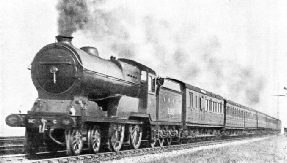
A SCOTTISH TRAIN. An Edinburgh-Glasgow express on the LNER. The distance between the two great cities by the express route of this railway is 47¼ miles, via Linlithgow, Polmont, and Croy. There are two other routes between Edinburgh and Glasgow, one LNER, the other LMS.
One of the most interesting and old-established cross-country services in Great Britain also has its connexion with Newcastle. Before the war of 1914-1918 a restaurant car express of the Great Eastern Railway left York daily at 4 pm for Harwich, on the Essex coast, to make connexion with the Continental steamers to the Hook of Holland and Antwerp. Through coaches, which had come over the Great Central Railway from Liverpool and Manchester, were attached at Lincoln. From Black Carr Junction at Doncaster for ninety-four miles to March, in Cambridgeshire, the train travelled over what was then the Great Northern and Great Eastern Joint Line.
Since the grouping of the railways in 1923, however, the working has been altered. The main train with the restaurant cars now starts at Liverpool (Central) at 2.20 pm and runs over the Cheshire Lines Committee’s main line to Manchester (Central). Here reversal takes place, and to the other end of the train there is attached a three-cylinder 4-6-0 locomotive of the “Sandringham” class, which is stabled at Ipswich, in Suffolk, and has come through from Ipswich to Manchester, a journey of 213 miles, on the previous day. Leaving Manchester at 3.10 pm the “North Country Continental”, as it is called, threads Woodhead Tunnel on a non-stop run to Sheffield, and then, crossing the East Coast main line on the level at Retford, reaches Lincoln at 5.20 pm.
Here is waiting the portion which left York at 3.30 pm. This portion incorporates a through coach that left distant Glasgow at 8.40 in the morning, and has come down through Edinburgh and Newcastle, The daily journey of this vehicle is 471 miles and occupies twelve hours forty-nine minutes. Running south through Spalding to March, which is reached at 6.49 pm, the “North Country Continental” here acquires two through coaches which left Birmingham (New Street) at 4 pm and have travelled across country by way of Rugby and Peterborough on the LMS.
“Sunny South Express”
The remaining stage is through Ely and Bury St. Edmunds to Ipswich, and finally to Parkeston Quay, where the boat connexions are made. Parkeston Quay is reached at 9.16 pm, and Harwich at 9.29 pm. The entire journey of 268 miles from Liverpool has thus occupied just over seven hours.
The train itself, as finally made up from March onwards, is unique as incorporating in one formation through vehicles from Glasgow, Edinburgh, Newcastle, Liverpool, Manchester, Sheffield, and Birmingham - seven of Britain’s biggest cities.
Another important highway to the east coast, and to Cromer, Yarmouth, and Lowestoft in particular, is over the Midland and Great Northern Joint Railway, which is connected with the Midland Division of the LMS at Saxby, just south of Melton Mowbray. Trains from Birmingham, via Leicester, and from Liverpool and Manchester, via Crewe, Stoke-on-Trent, and Nottingham, come this way.
Reference must also be made to one of the best-known of Britain’s cross-country trains - the “Sunny South Express”. For many years this was a daily service, but it is now run only at week-ends, except during the height of the summer. This connects Liverpool, Sheffield, Manchester, and Birmingham with Brighton, Eastbourne, and Hastings, and also carries a portion to and from Herne Bay, Margate, and Ramsgate. The heart of London is avoided by means of the West London and West London Extension Railways from Willesden Junction (where the Southern Railway takes the train over from the LMS) through Addison Road.
On Saturdays in the summer many other special through cross-country services are run, connecting the great industrial centres with various popular seaside resorts.
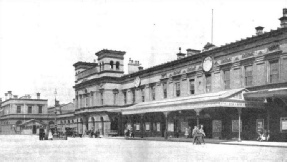
CHESTER STATION, on the route of the “Irish Mail” from London to Holyhead, is served also by a cross-country express that runs on the Great Western and Southern Railways from Birkenhead (Cheshire) to Southampton and Bournemouth, and by another from Birkenhead to seaside resorts on the Kent and Sussex coasts. These trains run via Shrewsbury, Birmingham, and Oxford.
You can read more on
“The 3.20 Down Manchester”,
“Britain’s Inland System”,
“The North Country Continental” and
“Three Joint Railways”
on this website.









